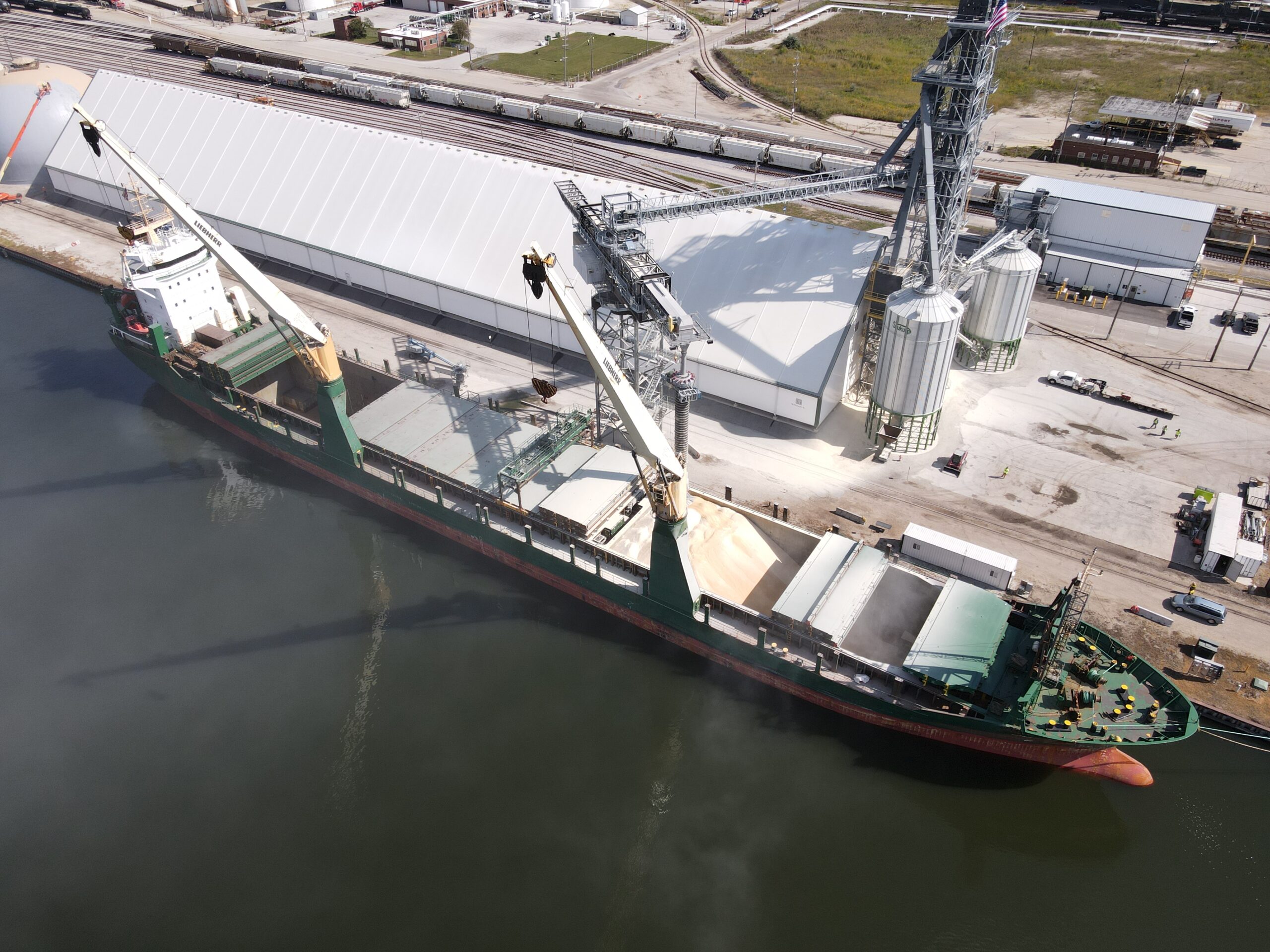
Nestled on the shores of Lake Michigan on Jones Island, Milwaukee’s newly updated port is emerging as a potential force in the city’s economy. Port Milwaukee aims to unlock opportunities for business, industry, and the community with updated facilities to include agricultural exports. The port’s backers hope the ripple effects will redefine Milwaukee’s role in the Great Lakes economy.
Port Milwaukee opened in 1835 to take advantage of the three rivers that meet there along the shores of Lake Michigan. For many years, the Canadian Pacific Railway’s (CPR) intermodal container service meant large containers could be moved between ship, rail, or truck without tampering with the cargo inside. But when CPR shuttered its service in 2012, Wisconsin businesses were forced to move most of their operations through Chicago via truck, increasing shipping costs and carbon emissions.
Enter Clinton, Wisconsin-based DeLong Company, the largest U.S. exporter of containerized agricultural products. In 2021, they broke ground on the port, renovating the facility’s structure from the 1950s.
“We’ve always known that feed ingredients could be economically viable in the Great Lakes,” said Brandon Bickham, director of exports and sales director at DeLong. “Most of the Great Lakes’ exports are whole grains. So, soybeans and wheat, traditionally, that’s the lion’s share of the ag exports.”
After opening in July of 2023, the updated port changed Jones Island from a place that only exported loose cargo — such as salt, steel, or limestone — into one that could process agricultural goods.
Port Milwaukee is now unique in its ability to handle various agricultural products, including distillers dried grains with solubles, commonly known as animal feed. Historically, DeLong focused on containerized exports, mainly to Asia, but the new modifications in this facility open the company to entirely new markets in North Europe, North Africa, and the Mediterranean.
Since breaking ground on the expansion in 2021, the port has doubled its net income to $1.1 million. It hopes to expand its service with state-grown corn, grain, and soybeans. On November 3, Port Milwaukee received a federal grant through the Department of Transportation, to fund additional grain storage capacity to help bolster the effort.
“When you look at agriculture, in general, it’s a huge part of our GDP, and it creates a lot of jobs,” said Bickham. “Obviously we’re a top ag producer in the world. We can’t consume it all. So, we need to look at the most efficient ways of exporting it out of our country.”
Bringing industry back

Vessel loaded with soybean meal. (Photo courtesy of Port Milwaukee)
According to Jackie Cater, director of Port Milwaukee, even though the port has a staff of just 21, its reach goes well beyond that because the private businesses which rent out different parts of the port hire hundreds of people, including truck drivers and brokers.
“The function of Port Milwaukee is not just the city department that manages land, our function also extends into the idea that we are an extension of commerce for the city, for the region, for the state,” said Carter. “That’s been demonstrated, not just through our commercial operations, but also through the recreational opportunities. We have Great Lakes cruising that is another big thing that’s happening in Port Milwaukee and we’re seeing really good success with that.”
Carter also noted that shipping vessels emit less carbon per cargo volume than trucks or rail. That’s because they can carry more and take fewer trips.
Meanwhile, Sandi Siegel, president and managing director of M.E. Dey, said she hopes the port’s expansion will bring more business back to the state.
M.E. Dey is a Milwaukee-based customs broker and freight forwarder business established in 1907. According to Siegel, most of her importing and exporting no longer happens in the state.
Over the past two decades, brokers stopped working in the cities where they were based. Now, a broker in New York can handle cargo in Milwaukee, she said.
“I am so passionate about Wisconsin and the industry here and I want to be careful about not make it sound doom and gloom,” said Siegel. “The reality is, I do so little in Wisconsin anymore. I am very excited about some of the growth at the port.”
According to Siegel, Wisconsin’s lack of intermodal service has been a huge issue. Airlines don’t offer direct flights to many smaller cities, and the same is true for rail. Most containerized freight destined for Wisconsin is dropped off in Chicago or in other rail yards in Illinois.
“From a customs perspective and a shipping perspective, the closest ports are Chicago, so any activity or growth in Wisconsin is exciting,” said Siegel.
While Port Milwaukee’s transformation will make it easier to move heavy agriculture — an essential piece of international trade — the next big piece is to re-establish intermodal rail services into Wisconsin.
“There’s a lot of us working very hard to get rail service back to Wisconsin so that it doesn’t have to be trucked from the very congested roads in Illinois,” said Seigel.
Catch more news at Great Lakes Now:
Charting a Safer Course: Mitigating flood risk in Great Lakes states
Keeping an eye on Michigan’s current environmental legislation
Featured image: Vessel loaded with DDGs. (Photo courtesy of Port Milwaukee)




